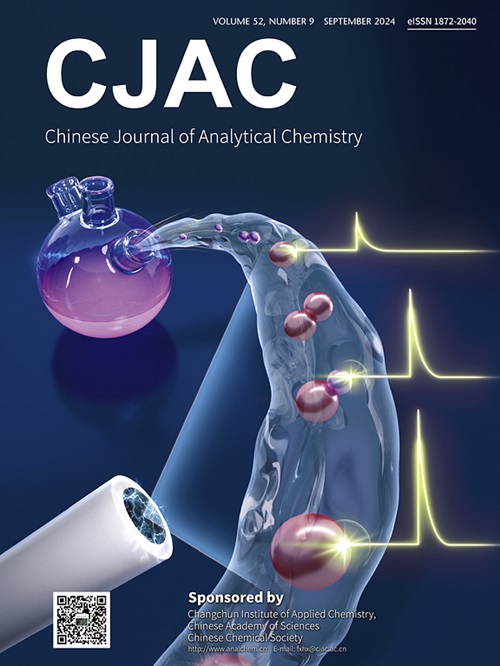Physiological response of Bidens pilosa to cadmium stress monitored by fourier transform infrared spectroscopy
IF 1.2
4区 化学
Q4 CHEMISTRY, ANALYTICAL
引用次数: 0
Abstract
The cadmium (Cd) pollution of soil causes serious environmental problems. The present paper deals with the physiological response of the changes in chemical components in the root, stem and leaf of Bidens pilosa seedlings stressed by excess cadmium ions (Cd2+) using Fourier transform infrared spectroscopy technique (FTIR). Cadmium accumulation in plant and distribution in subcellular by atomic absorption spectroscopy were tested under different concentrations cadmium stress. Results indicated that at a Cd concentration of 7 mg·L–1, B. pilosa maintained normal growth without visible Cd toxicity symptoms, though biomass was reduced compared to controls. FTIR analysis revealed that the overall peak shapes of roots, stems, and leaves remained largely unchanged before and after heavy metal treatment, suggesting that the structural integrity of plant organs was not compromised. However, shifts in specific functional group absorption peaks, including hydroxy (3387–3417 cm–1), carboxyl (1411–1419 cm–1), and amide groups (1635 cm–1), were observed, indicating their involvement in the heavy metal absorption process. The characteristic peak intensity of leaves was higher at high Cd concentration than at medium-low Cd concentration, while peaks in stems and roots remained consistent with or exceeded those of the control group. Cd predominantly accumulated in cell walls (46.21%–55.32%) and was minimally distributed in chloroplasts and mitochondria (4.11%–8.43%). These findings suggest that B. pilosa exhibits strong tolerance to Cd-contaminated soil and has significant potential for phytoremediation. The FTIR method offers strong evidence supporting the development of phytoremediation technology.
傅里叶变换红外光谱法监测毛拜登对镉胁迫的生理响应
土壤镉污染造成了严重的环境问题。利用傅里叶变换红外光谱技术(FTIR)研究了过量镉离子(Cd2+)胁迫下毛拜登(Bidens pilosa)幼苗根、茎、叶化学成分变化的生理响应。采用原子吸收光谱法测定了不同浓度镉胁迫下植物体内镉的积累和亚细胞内镉的分布。结果表明,在Cd浓度为7 mg·L-1时,毛囊白杨的生物量较对照有所减少,但仍能保持正常生长,无明显的Cd毒性症状。FTIR分析显示,重金属处理前后植物根、茎、叶的整体峰形基本保持不变,表明植物器官的结构完整性没有受到损害。然而,羟基(3387-3417 cm-1)、羧基(1411-1419 cm-1)和酰胺基(1635 cm-1)等特定官能团的吸收峰发生了变化,表明它们参与了重金属的吸收过程。高镉浓度下,叶片特征峰强度高于中低镉浓度,茎、根特征峰强度与对照组基本一致或超过对照组。Cd主要积聚在细胞壁(46.21% ~ 55.32%),少量分布在叶绿体和线粒体(4.11% ~ 8.43%)。这些结果表明,金丝桃对cd污染土壤具有较强的耐受性,具有很大的植物修复潜力。FTIR方法为植物修复技术的发展提供了有力的证据。
本文章由计算机程序翻译,如有差异,请以英文原文为准。
求助全文
约1分钟内获得全文
求助全文
来源期刊
CiteScore
3.60
自引率
25.00%
发文量
17223
审稿时长
35 days
期刊介绍:
Chinese Journal of Analytical Chemistry(CJAC) is an academic journal of analytical chemistry established in 1972 and sponsored by the Chinese Chemical Society and Changchun Institute of Applied Chemistry, Chinese Academy of Sciences. Its objectives are to report the original scientific research achievements and review the recent development of analytical chemistry in all areas. The journal sets up 5 columns including Research Papers, Research Notes, Experimental Technique and Instrument, Review and Progress and Summary Accounts. The journal published monthly in Chinese language. A detailed abstract, keywords and the titles of figures and tables are provided in English, except column of Summary Accounts. Prof. Wang Erkang, an outstanding analytical chemist, academician of Chinese Academy of Sciences & Third World Academy of Sciences, holds the post of the Editor-in-chief.

 求助内容:
求助内容: 应助结果提醒方式:
应助结果提醒方式:


